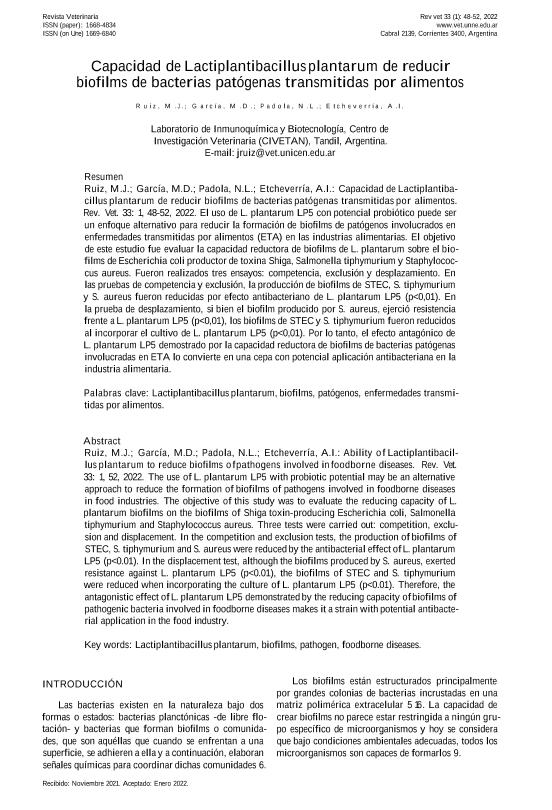Artículo
El uso de L. plantarum LP5 con potencial probiótico puede ser un enfoque alternativo para reducir la formación de biofilms de patógenos involucrados en enfermedades transmitidas por alimentos (ETA) en las industrias alimentarias. El objetivo de este estudio fue evaluar la capacidad reductora de biofilms de L. plantarum sobre el biofilms de Escherichia coli productor de toxina Shiga, Salmonella tiphymurium y Staphylococcus aureus. Fueron realizados tres ensayos: competencia, exclusión y desplazamiento. En las pruebas de competencia y exclusión, la producción de biofilms de STEC, S. tiphymurium y S. aureus fueron reducidas por efecto antibacteriano de L. plantarum LP5 (p<0,01). En la prueba de desplazamiento, si bien el biofilm producido por S. aureus, ejerció resistencia frente a L. plantarum LP5 (p<0,01), los biofilms de STEC y S. tiphymurium fueron reducidos al incorporar el cultivo de L. plantarum LP5 (p<0,01). Por lo tanto, el efecto antagónico de L. plantarum LP5 demostrado por la capacidad reductora de biofilms de bacterias patógenas involucradas en ETA lo convierte en una cepa con potencial aplicación antibacteriana en la industria alimentaria. The use of L. plantarum LP5 with probiotic potential may be an alternative approach to reduce the formation of biofilms of pathogens involved in foodborne diseases in food industries. The objective of this study was to evaluate the reducing capacity of L. plantarum biofilms on the biofilms of Shiga toxin-producing Escherichia coli, Salmonella tiphymurium and Staphylococcus aureus. Three tests were carried out: competition, exclusion and displacement. In the competition and exclusion tests, the production of biofilms of STEC, S. tiphymurium and S. aureus were reduced by the antibacterial effect of L. plantarum LP5 (p<0.01). In the displacement test, although the biofilms produced by S. aureus, exerted resistance against L. plantarum LP5 (p<0.01), the biofilms of STEC and S. tiphymurium were reduced when incorporating the culture of L. plantarum LP5 (p<0.01). Therefore, the antagonistic effect of L. plantarum LP5 demonstrated by the reducing capacity of biofilms of pathogenic bacteria involved in foodborne diseases makes it a strain with potential antibacterial application in the food industry.
Capacidad de Lactiplantibacillus plantarum de reducir biofilms de bacterias patógenas transmitidas por alimentos
Título:
Ability of Lactiplantibacillus plantarum to reduce biofilms of pathogens involved in foodborne diseases
Fecha de publicación:
04/2022
Editorial:
Universidad Nacional del Nordeste. Facultad de Ciencias Veterinarias
Revista:
Revista Veterinaria
ISSN:
1668-4834
e-ISSN:
1669-6840
Idioma:
Español
Tipo de recurso:
Artículo publicado
Clasificación temática:
Resumen
Palabras clave:
BIOFILMS
,
FOODBORNE DISEASES
,
LACTIPLANTIBACILLUSPLANTARUM
,
PATHOGEN
Archivos asociados
Licencia
Identificadores
Colecciones
Articulos(CIVETAN)
Articulos de CENTRO DE INVESTIGACION VETERINARIA DE TANDIL
Articulos de CENTRO DE INVESTIGACION VETERINARIA DE TANDIL
Articulos(ICIVET-LITORAL)
Articulos de INST. DE CIENCIAS VETERINARIAS DEL LITORAL
Articulos de INST. DE CIENCIAS VETERINARIAS DEL LITORAL
Citación
Ruiz, María Julia; García, Mauro Daniel; Padola, Nora Lía; Etcheverría, Analía Inés; Capacidad de Lactiplantibacillus plantarum de reducir biofilms de bacterias patógenas transmitidas por alimentos; Universidad Nacional del Nordeste. Facultad de Ciencias Veterinarias; Revista Veterinaria; 33; 1; 4-2022; 48-52
Compartir
Altmétricas




